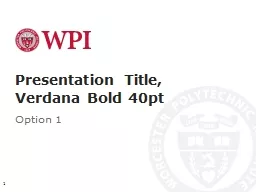

Office of Human Resources amp Payroll 1 Points to Consider What is the Performance Communication Process and why do we do it Why are these communications so difficult Why does this process so often fail to meet its intentions ID: 358092
Download Presentation The PPT/PDF document "Performance Communication Process" is the property of its rightful owner. Permission is granted to download and print the materials on this web site for personal, non-commercial use only, and to display it on your personal computer provided you do not modify the materials and that you retain all copyright notices contained in the materials. By downloading content from our website, you accept the terms of this agreement.
Slide1
Performance Communication Process
Office of Human Resources & Payroll
1Slide2
Points to Consider
What is the Performance Communication Process and why do we do it?
Why are these communications so difficult?
Why does this process so often fail to meet its intentions?
What are some common “errors” that occur during this process?
2Slide3
Performance Communication Process
VOICE – Virtue, Output, Integrity, Collaboration, ExcellenceAllows employees and supervisors to openly discuss feedback in a formal
way
Designed
to highlight and support each person’s contributions to the WPI communityHelps to measure skills, accomplishments, and developmental needsProvides an opportunity for goal setting for the year ahead3Slide4
Performance Communication Process
Supervisors gain an understanding of each employee’s ever evolving strengths, abilities, and developmental needsEmployees have an opportunity to assess their position and set goals for the upcoming year
A careful review stimulates employees’ interest and motivation for improved job performance and professional satisfaction.
4Slide5
Common Struggles
So why do we dislike performance reviews so much?The process takes too long (good news, it is now much shorter!)
Fear of confrontation
Employee’s strength in one area overshadows areas that may need
development, or vice versaLack of support documentation
5Slide6
Common Struggles
What can we do to overcome these perceived roadblocks?Learn the process, use the system … give
it a shot!
Approach a difficult conversation with care
Assume an attitude of helpfulnessEmpathize and listen activelyGive specific examples – keep emotions out of itDescribe the behavior without judging the behaviorDocument situations as they occurKeep notes on all of your employees, not just a fewSupport observations with facts
6Slide7
Common Struggles
Reasons employees don’t meet performance standards:Have not received adequate training
Are not clear on their job responsibilities
Are not receiving reinforcement or feedback for a job well done, or for missing the mark
Don’t want to do it your way7Slide8
Best Intentions …
Sometimes, performance communication plans fail to make an impact … but why?Lack of follow-up
Provides recognition
Allows continuing communication
Additionally, was there:Up-to-date job description?Clear and well-defined performance standards / goals?On-going feedback about performance throughout the year?Open and active communication?Trust and respect between you and your employee?
8Slide9
Performance Ratings
Trailblazer – Regularly goes above and beyond and surpasses expectations of the positionSolid Performer – Consistently meets expectations and occasionally exceeds expectations
Developing – Performing at an acceptable level of performance and requires development in an area
Needs Improvement – Inconsistent performance and/or performing below expectations.
9Slide10
Common Errors
10
Credit: Society for Human Resource Management
Halo - One good trait overshadows
Horn - One negative trait overshadowsRecency - More weight to recent actionsPrimacy - More weight to early actionsBias - Personal judgments
Strictness - Rating employee unrealistically lowLeniency - Rating employee unrealistically highCentral Tendency - Everyone is rated the same
Contrast - Comparing employees against each other instead of against standardsSlide11
An Effective Performance Appraisal …
Acknowledges and celebrates strengths and accomplishments
Provides
honest feedback for areas needing
improvement – focus on the futureClearly communicates expectations, and is part of the on-going communication between supervisors and employeesResults in merit increases that truly reflect the performance of the individual11Slide12
Questions?
Your VOICE will be heard!
Thank You
12Slide13